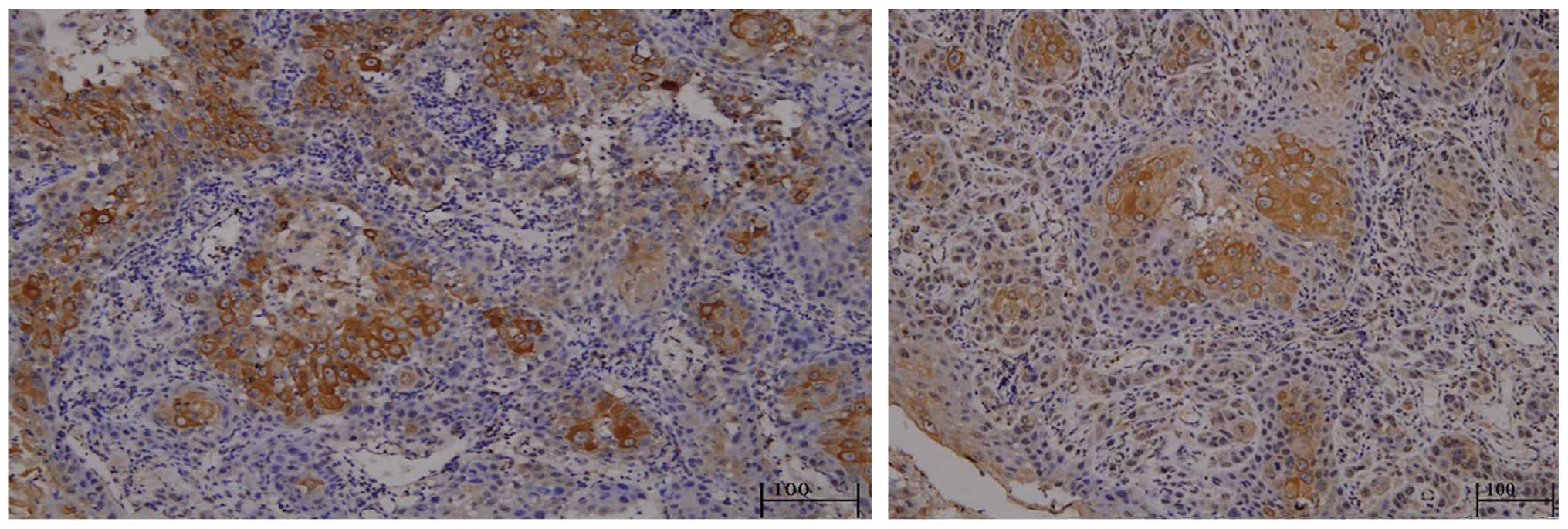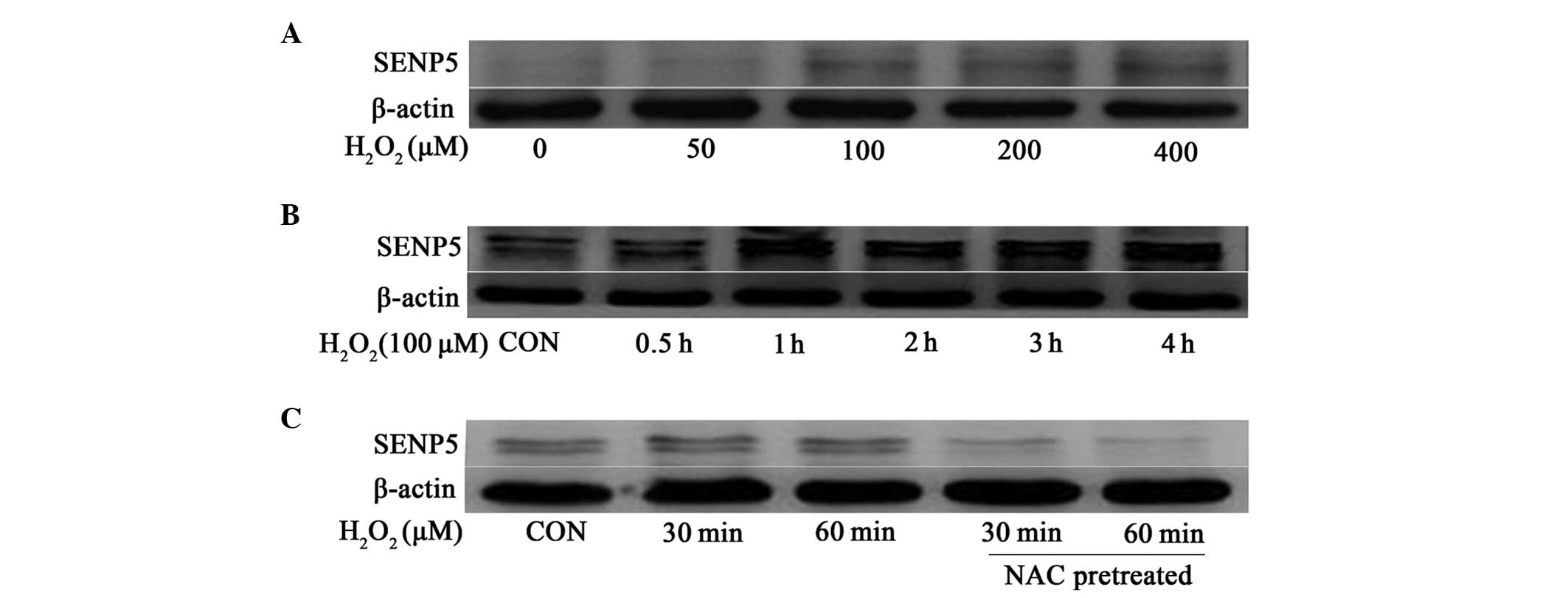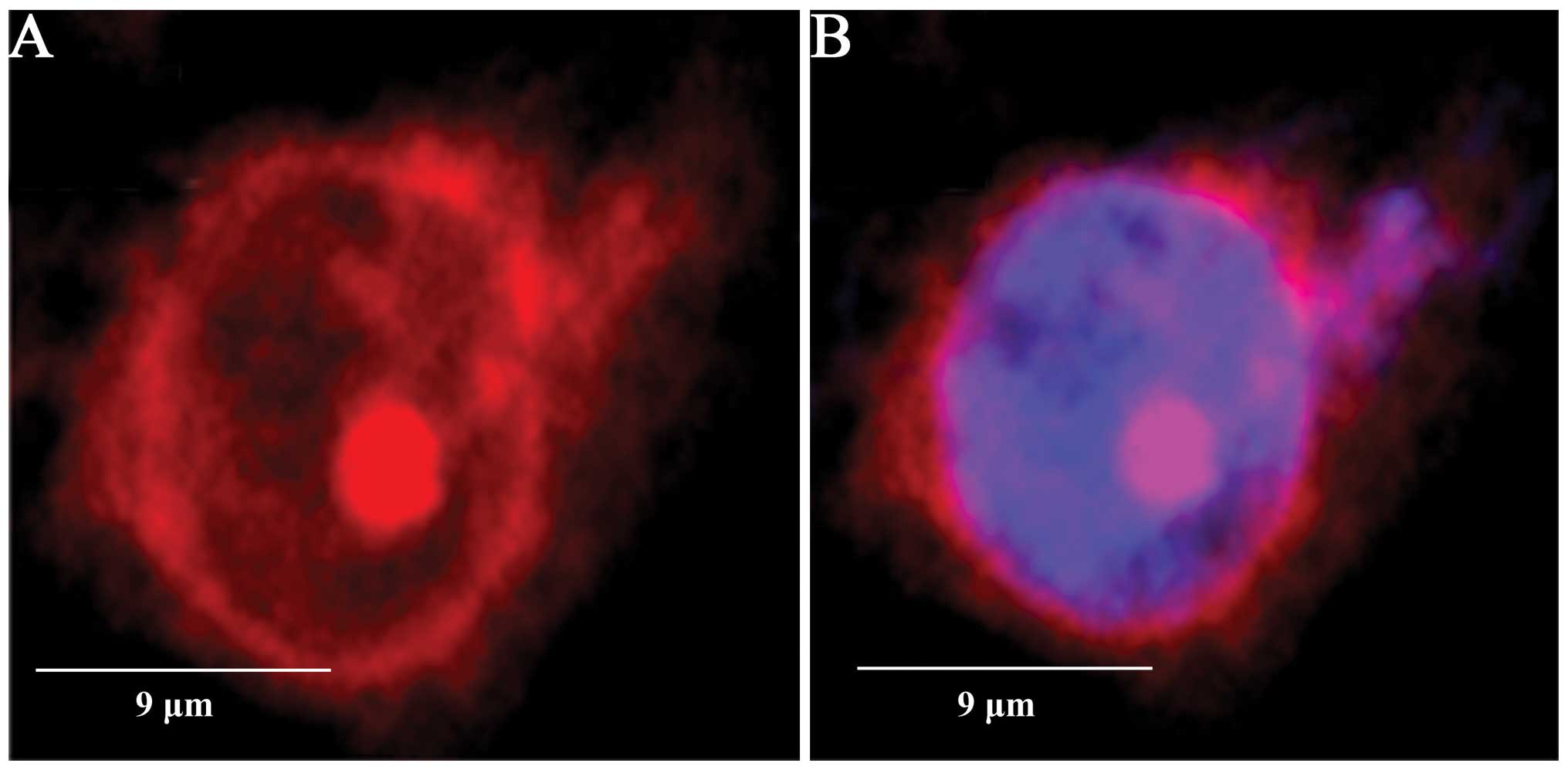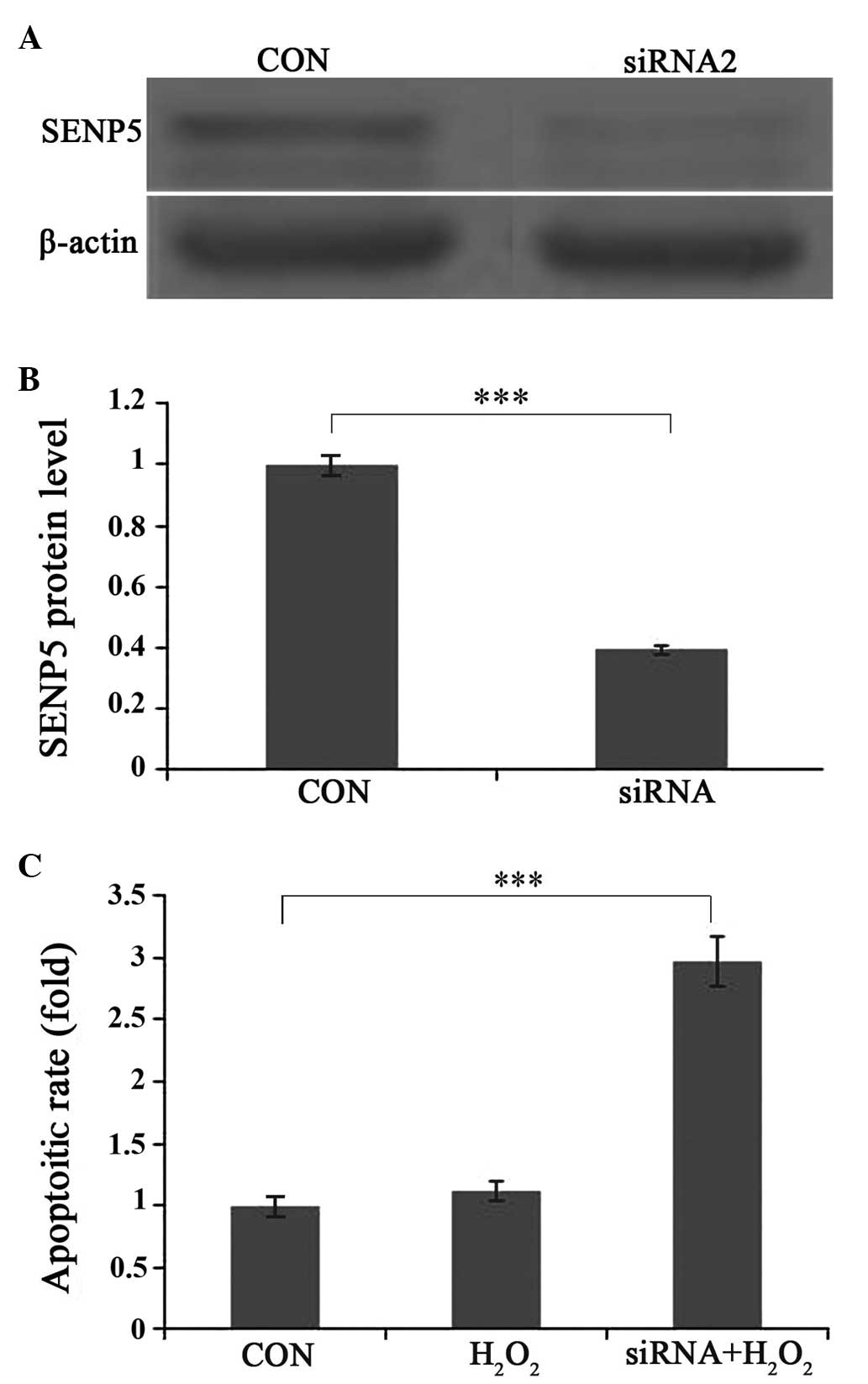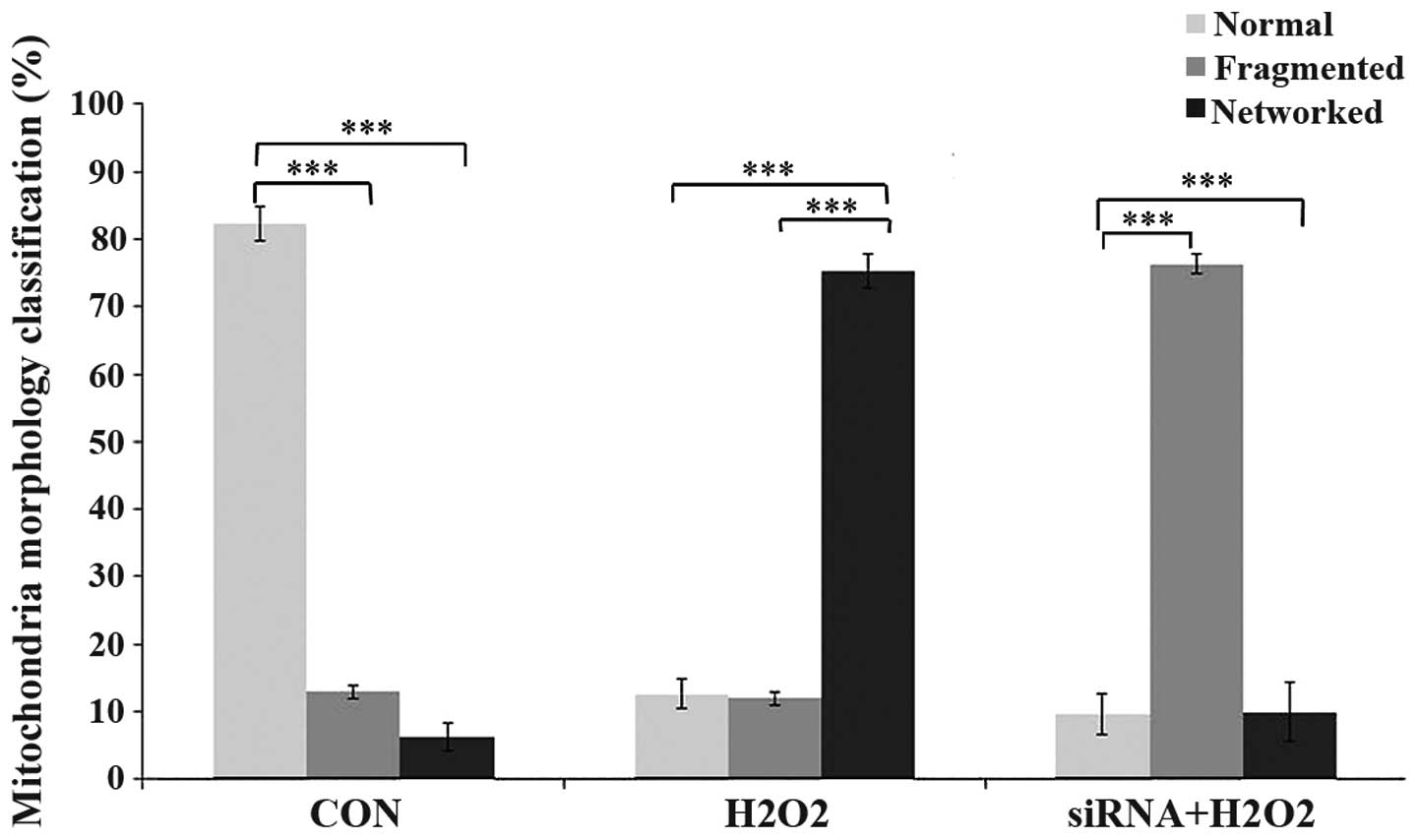Sentrin/small ubiquitin-like modifier-specific protease 5 protects oral cancer cells from oxidative stress-induced apoptosis
- Authors:
- Published online on: April 22, 2015 https://doi.org/10.3892/mmr.2015.3662
- Pages: 2009-2014
Abstract
Introduction
Small ubiquitin-like modifiers (SUMOs) are covalently bonded proteins, and SUMOylation is a post-translational protein modification, which regulates the activities of a wide spectrum of substrate proteins (1), which are involved in the regulation of gene expression, signal transduction, chromosome integrity, DNA replication and repair, cell division, nuclear trafficking and mitochondrial function (2–8). Similar to ubiquitination, SUMOylation is catalyzed by the E1-activating enzyme complex, E2-conjugating enzyme and E3 ligases, however, the covalent bonding of the SUMO proteins can be reversed by sentrin/SUMO-specific proteases (SENPs) (9). SENP-mediated de-SUMOylation is involved in various cell processes, including hypoxia, cell cycle regulation and cell division, development and differentiation, neurodegeneration, rRNA processing and androgen receptor signaling (10–18). The balance between SUMOylation and de-SUMOylation has been suggested to be crucial for cellular health, and disturbaces in homeostasis are considered to facilitate the development and progression of cancer (19). Oxidative stress is mediated through the production of reactive oxygen species (ROS), which are induced by a number of endogenous and exogenous processes, including temperature and pH changes, osmotic pressure, oxygen tension and high sugar concentrations (20). Homeostatic ROS control is one of the key determinants for maintaining cell growth and proliferation (20), and SENP5, which is a SUMO2/3-specific protease, has been reported to be important in cellular adaptive responses to the production of ROS, by regulating the balance between SUMOylation and de-SUMOylation (21–23). Oral squamous cell carcinoma (OSCC), is the eighth most prevalent type of cancer and accounts for 2% of all cancer-associated mortality worldwide (24). OSCC is often diagnosed at an advanced stage and the overall 5-year survival rate is <50% (25,26). The mechanisms involved in the tumorigenesis of OSCC remain to be fully elucidated, however, a number of studies have demonstrated that the development of OSCC is correlated with oxidative stress (27,28). Although SUMO2/3 conjugation is a response to oxidative stress, its involvement in OSCC has not been previously demonstrated. Therefore, the aims of the present study were to investigate the activities of SENP5 in an OSCC cell line and to determine its correlation with oxidative stress.
Materials and methods
Cell culture
CAL-27 cells were obtained from the Laboratory of Oral Oncology, Ninth People’s Hospital, School of Medicine, Shanghai Jiaotong University (Shanghai, China) and maintained in Dulbecco’s modified Eagle’s medium (DMEM) supplemented with 10% fetal bovine serum (FBS; Gibco Life Technologies, Carslbad, CA, USA),100 U/ml penicillin and 100 mg/l streptomycin (Beyotime Institute of Biotechnology, Nantong, China). The CAL-27 cells were cultured in a humidified atmosphere of 5% CO2 at 37°C. To investigate associations with ROS, the cells were treated with H2O2 and N-acetyl cysteine (NAC; Beyotime Institute of Biotechnology, Haimen, China).
Tissue samples
Archived paraffin-embedded tissue specimens from 31 previously untreated patients were obtained from the Department of Pathology, Zhongshan Hospital, Fudan University (Shanghai, China). Of the 31 patients, 9 were female and 22 were male and the median age was 61.8 years (range, 45–88 years). A total of 26 tumors originated from the tongue and 5 tumors were buccal. Written informed consent was obtained from the patients and the patients’ families.
Immunohistochemistry
For immunohistochemistry, the 5 µm sections (cut with a microtome and mounted onto poly-lysine coated slides) were treated with xylene (Beyotime Institute of Biotechnology) for 10 min, alcohol hydration (70%; Changshu Yangyuan Chemical Co., Ltd., Changshu, China) for 15 min and methanol (Beyotime Institute of Biotechnology), containing 3% H2O2, for 10 min. The sections were then washed in phosphate-buffered saline (PBS) containing 0.1% Triton X-100 (Bio Basic, Inc., Toronto, ON, Canada) for 5 min, blocked with 5% bovine serum albumin (BSA; Beyotime Institute of Biotechnology) for 1 h at room temperature and then incubated with rabbit polyclonal antibody against SENP5 (1:80; AP1237a; Abgent, Inc., San Diego, CA, USA) overnight at 4°C. The sections were then incubated with biotinylated mouse anti-rabbit monoclonal immunoglobulin (Ig)G (1:1,000; Cell Signaling Technology, Inc., Boston, MA, USA) for 1 h at room temperature and then washed twice with PBS, containing 0.01% Tween 20 (Beyotime Institute of Biotechnology). Following incubation with horseradish peroxidase (HRP)-conjugated avidin in PBS-0.01% Tween for 20 min at room temperature, developing solution [DAB Detection kit (polymer); Genetic Technology Co., Ltd., Shanghai, China] was added and the sections were counterstained with hematoxylin (Beyotime Institute of Biotechnology) for 10 min and cover-slips (Beyotime Institute of Biotechnology) were mounted onto the slides using 50% glycerin (Beyotime Institute of Biotechnology). Images of the stained samples were captured using an Olympus Fluoview FV100 (Olympus, Tokyo, Japan).
SENP5 small interfering (si)RNA construction
siRNA specific for SENP5 and control non-specific siRNA oligonucleotides were synthesized byGenePharma (Shanghai, China). The sequences of the siRNA oligonucleotides were as follows: Short hairpin (sh)RNAI, 5′-TGCTGTTGACAGTGAGCGACCAGTTTACTTGGAATAGACAGTAGTGAAGCCACAGATGTA-3′ and shRNAII, 5′-TGCTGTTGACAGTGAGCGCGCGCAGATGGTTTGTTACTTGAATAGTGAAGCCACAGATGTAT-3′. The cells were transfected with siRNA oligonucleotides using Lipofectamine 2000 (Gibco Life Technologies), according to the manufacturer’s instructions.
Western blotting
The cells (6×105) were lysed in 0.1 ml sample buffer (0.1% SDS, 1% NP-40, 50 mM HEPES, pH 7.4, 2 mM EDTA, 100 mM NaCl, 5 mM sodium orthovanadate and 1% protease inhibitor mixture set I; EMD Millipore, San Diego, CA, USA) on ice for 30 min. Following centrifugation at 13,400 × g (Eppendorf Centrifuge 5415 D; Eppendorf AG, Hamburg, Germany) for 15 min, the supernatants were removed. The proteins were then quantified using a BCA Protein Assay kit (Pierce Biotechnology, Inc., Rockford, IL, USA), according to the manufacturer’s instructions. The samples, adjusted to a total of 50 µg protein, were heated at 100°C for 5 min in 2X SDS sample buffer, and then separated on 10 or 12% SDS-PAGE gels (Nanjing KeyGen Biotech. Co., Ltd., Nanjing, China) and transferred onto polyvinylidene difluoride membranes (Merck Millipore, Darmstadt, Germany). The membranes were incubated with blocking buffer (5% BSA), followed by incubation with rabbit polyclonal antibodies against SENP5 (1:50; AP14400b; Abgent, Inc.) at 4°C overnight and HRP-conjugated secondary mouse anti-rabbit IgG (1:1,000; sc-2357; Santa Cruz Biotechnology, Inc., Santa Cruz, CA, USA) for 2 h at room temperature prior to analysis using an enhanced chemiluminescence system (Beyotime Institute of Biotechnology).
Immunostaining
The CAL-27 cell monolayers were fixed using 4% paraformaldehyde (Beyotime Institute of Biotechnology), permeabilized with 0.2% Triton X-100 and blocked with 5% BSA prior to incubation with the rabbit polyclonal antibody against SENP5 (1:50; AP1237a; Abgent, Inc.) at 4°C overnight. The cover slides were then mounted with medium containing 4′,6-diamidino-2-phenylindole (Beyotime Institute of Biotechnology) for 5 min to visualize the cell nuclei, then subsequently were incubated with Rhodamin-conjugated goat anti-rabbit antibody (1:1000; Abcam) for 1.5 h at room temperature prior to washing twice with PBS. The slides were evaluated using a laser-scanning confocal microscope (FV100; Olympus). A mitochondria tracker (GMS10020.1; Shanghai Baoman Biological Technology Co., Ltd., Shanghai, China) was used, according to the manufacturer’s instructions. MitoTracker® stock solution (1 mM) was diluted to a working concentration of 100 nM in growth medium, then once the cells reached the desired confluency, the media was removed from the dish and prewarmed (37°C) staining solution containing MitoTracker® probe, which was prepared prior to incubation, was added for 15 min under growth conditions. Subsequently, fixing, rinsing and permeabilization was performed.
Flow cytometry
The CAL-27 cells (6×105) were grown in complete culture medium (DMEM, supplemented with 10% heat inactivated FBS, 100 IU/ml penicillin and 100 mg/ml streptomycin) and silenced using SENP5-siRNA, according to the manufacturer’s instructions. The cells were treated with H2O2 and SENP5-siRNA, as indicated, and then fixed using ice-cold ethanol for 20 min, prior to staining with 50 µg/ml propidium iodide (Sigma-Aldrich, St. Louis, MO, USA) and 100 µg/ml RNase A (Beyotime Institute of Biotechnology) for 20 min at room temperature. The DNA content of the cells was then determined by fluorescence-activated cell sorting, using a 488 nm laser (FACSAria; BD Bioscienes, Franklin Lakes, NJ, USA).
Results
The results of the SENP5 staining in the 31 tissue specimens revealed that SENP5 was predominantly expressed in the cytosols of the inner layer tumor cells (Fig. 1).
Mild oxidative stress induces rapid protein stabilization of SENP5
ROS generation is common to various stress inducers, including hypoxia, low pH and ultraviolet radiation (29). In order to examine the association between SENP5 and ROS in the present study, CAL-27 OSCC cells were exposed to varying concentrations of H2O2, and the expression of SENP5 was evaluated. Initially, the cells were incubated with increasing concentrations of H2O2 for 1 h and SENP5 protein accumulated in the cells in a dose dependent manner, beginning at 100 µM H2O2 (Fig. 2A). The following time-course experiments revealed that the protein levels of SENP5 started to increase following 1 h exposure to 100 µM H2O2 and remained stable. Notably, hypoxia had a similar effect on the protein levels of SENP5 (data not shown). Subsequently, the present study examined whether the increased protein levels of SENP5 were inhibited by antioxidants, including NAC. As shown in Fig. 2C, the addition of NAC to the medium reversed the H2O2-induced accumulation of SENP5 in the CAL-27 cells, suggesting that the protein levels of SENP5 were regulated by changes in redox states.
SENP5 is predominantly localized in the cytosol of CAL-27 cells
The de-SUMOylation activity of SENPs is directed by their subcellular distribution (30), and SENP5 has been reported to be preferentially expressed in the nucleoli (31). In the present study, however, SENP5 was also found to be localized in the cytoplasm in 84.2±2.6% of the CAL-27 cells (Fig. 3), which was not affected by H2O2 application (data not shown).
Moderate oxidative stress induces apoptosis in SENP5-silenced CAL-27 cells
To examine the importance of SENP5 on cell survival, shRNAs were designed to silence the expression of SENP5. Western blot analyzes reavealed a 65% reduction in protein expression (Fig. 4A and B). To assess whether knockdown of SENP5 had an effect on apoptosis, the cells were divided into control; 1 h 100 µm H2O2 exposure; and 1 h 100 µm H2O2 + siRNA-SENP5 groups. As shown in Fig. 4C, H2O2 incubation alone enhanced apoptosis in the CAL-27 cells, whereas combined H2O2 incubation and SENP5 silencing increased the apoptotic rate significantly (P<0.001).
SENP5 is associated with mitochondria stabilization of H2O2-exposed CAL-27 cells
In order to further analyze the function of SENP5 in CAL-27 cell mitochondria, the present study determined the mitochondrial structures following either control siRNA application, the addition of 100 µm H2O2 for 1 h, or the addition of 100 µm H2O2 for the final 1 h of a 72 h period with SENP5 silencing using specific siRNA. Increased fused mitochondria were observed in the H2O2-treated group, compared with the control group, which suggested that ROS are associated with mitochondrial morphology. When SENP5 was silenced, exposure to H2O2 led to fragmentation of the mitochondria (Fig. 5).
Statistical analysis
Data are expressed as the mean ± standard deviation. Statistical analysis was performed using SPSS software, version 11.0 (SPSS, Inc., Chicago, IL, USA). The difference between two groups was analyzed using Student’s t-test or analysis of variance. P<0.05 was considered to indicate a statistically significant difference.
Discussion
In our previous study, SENP5 was observed to be predominantly expressed in well-differentiated cells, located at the inner layer of carcinoma nests, and was associated with the pathological degree of OSCC (32). SENP5 regulates the formation of SUMO-2 or SUMO-3 conjugates and, to a less extent, SUMO-1 modifications (31). Dynamin-1-like protein (Drp1) has been identified as a cytosolic substrate of SENP5 (33) and SUMO1-conjugated Drp1 is stabilized and involved in mitochondrial fragmentation, particularly during mitosis (34). However, SENP5 deSUMOylation leads to Drp1 inactivation due to transformation into its instable form. In COS-7 cells, Drp1 was stably mono-SUMOylated, however, a reduction of SENP5 resulted in increased free radical production, which was reversed by silencing Drp1 (33). It has been demonstrated that Drp1 protein is also essential for apoptotic mitochondrial fission (35,36). In the present study SENP5 was observed to rescue CAL-27 cells from ROS-induced apoptosis (Fig. 4C), which can be explained by its destabilization of Drp1 and is in agreement with a previous report regarding resistance to H2O2-induced cell death in a cell line containing an activity mutation of Drp1 (37). There have been few reports regarding SENP5 overexpression in OSCC cells (38), however, Katayama et al reported the overexpression of SUMO1 in OSCC cells (38). Since overexpression of SUMO1 leads to excessive Drp1 SUMOylation and results in mitochondrial fragmentation (39), and as SENP5 has been noted to localize predominantly in the nucleolus (15,40), its cytosolic accumulation in OSCC cells may represent a counter-reaction of the cells against enhanced susceptibility to ROS-induced apoptosis. Due to the rapid growth of tumor cells, the oxygen supply is inadequate in the center of cancer nests, and increased ROS development during hypoxia is common (41–43). A similar mechanism has been suggested for the overexpression of SENP1 in prostate cancer, and is suggested to be important for the protein stabilization of hypoxia-induced hypoxia-inducible factor 1α (44).
In conclusion, the present study demonstrated that SENP5 was overexpressed and accumulated in the cytosols of OSCC cells. Mild oxidative stress stabilized SENP5 in the CAL-27 cells, but did not enhance their apoptotic rates, whereas combined SENP5 silencing and mild oxidative stress led to mitochondria fragmentation and significantly increased cell apoptosis.
The findings of the current study demonstrate that SENP5 protected OSCC cells from oxidative stress-induced apoptosis, which may be of clinical importance for further treatment strategies for OSCC.
Acknowledgments
The current study was supported by the National Natural Science Foundation of China (no. 81001202).
References
|
Hay RT: SUMO: a history of modification. Mol Cell. 18:1–12. 2005. View Article : Google Scholar : PubMed/NCBI | |
|
Andreou AM and Tavernarakis N: SUMOylation and cell signalling. Biotechnol J. 4:1740–1752. 2009. View Article : Google Scholar : PubMed/NCBI | |
|
Dou H, Huang C, Van Nguyen T, Lu LS and Yeh ET: SUMOylation and de-SUMOylation in response to DNA damage. FEBS Lett. 585:2891–2896. 2011. View Article : Google Scholar : PubMed/NCBI | |
|
Finkbeiner E, Haindl M, Raman N and Muller S: SUMO routes ribosome maturation. Nucleus. 2:527–532. 2011. View Article : Google Scholar : PubMed/NCBI | |
|
Lomelí H and Vázquez M: Emerging roles of the SUMO pathway in development. Cell Mol Life Sci. 68:4045–4064. 2011. View Article : Google Scholar : PubMed/NCBI | |
|
Scorrano L and Liu D: The SUMO arena goes mitochondrial with MAPL. EMBO Rep. 10:694–696. 2009. View Article : Google Scholar : PubMed/NCBI | |
|
Ulrich HD: Ubiquitin and SUMO in DNA repair at a glance. J Cell Sci. 125:249–254. 2012. View Article : Google Scholar : PubMed/NCBI | |
|
Wan J, Subramonian D and Zhang XD: SUMOylation in control of accurate chromosome segregation during mitosis. Curr Protein Pept Sci. 13:467–481. 2012. View Article : Google Scholar : PubMed/NCBI | |
|
Yeh ET, Gong L and Kamitani T: Ubiquitin-like proteins: new wines in new bottles. Gene. 248:1–14. 2000. View Article : Google Scholar : PubMed/NCBI | |
|
Cheng J, Kang X, Zhang S and Yeh ET: SUMO-specific protease 1 is essential for stabilization of HIF1alpha during hypoxia. Cell. 131:584–595. 2007. View Article : Google Scholar : PubMed/NCBI | |
|
Cheng J, Perkins ND and Yeh ET: Differential regulation of c-Jun-dependent transcription by SUMO-specific proteases. J Biol Chem. 280:14492–14498. 2005. View Article : Google Scholar : PubMed/NCBI | |
|
Cheng J, Wang D, Wang Z and Yeh ET: SENP1 enhances androgen receptor-dependent transcription through desumoylation of histone deacetylase 1. Mol Cell Biol. 24:6021–6028. 2004. View Article : Google Scholar : PubMed/NCBI | |
|
Degerny C, Monte D, Beaudoin C, et al: SUMO modification of the Ets-related transcription factor ERM inhibits its transcriptional activity. J Biol Chem. 280:24330–24338. 2005. View Article : Google Scholar : PubMed/NCBI | |
|
Deyrieux AF, Rosas-Acosta G, Ozbun MA and Wilson VG: Sumoylation dynamics during keratinocyte differentiation. J Cell Sci. 120:125–136. 2007. View Article : Google Scholar | |
|
Di Bacco A, Ouyang J, Lee HY, et al: The SUMO-specific protease SENP5 is required for cell division. Mol Cell Biol. 26:4489–4498. 2006. View Article : Google Scholar : PubMed/NCBI | |
|
Dorval V and Fraser PE: SUMO on the road to neurodegeneration. Biochim Biophys Acta. 1773:694–706. 2007. View Article : Google Scholar : PubMed/NCBI | |
|
Haindl M, Harasim T, Eick D and Muller S: The nucleolar SUMO-specific protease SENP3 reverses SUMO modification of nucleophosmin and is required for rRNA processing. EMBO Rep. 9:273–279. 2008. View Article : Google Scholar : PubMed/NCBI | |
|
Halliwell B: Oxidative stress and cancer: have we moved forward? Biochem J. 401:1–11. 2007. View Article : Google Scholar | |
|
Bawa-Khalfe T and Yeh ET: SUMO losing balance: SUMO proteases disrupt SUMO homeostasis to facilitate cancer development and progression. Genes Cancer. 1:748–752. 2010. View Article : Google Scholar : PubMed/NCBI | |
|
Halliwell B: Oxidative stress in cell culture: an under-appreciated problem? FEBS Lett. 540:3–6. 2003. View Article : Google Scholar : PubMed/NCBI | |
|
Guo C, Hildick KL, Luo J, et al: SENP3-mediated deSUMOylation of dynamin-related protein 1 promotes cell death following ischaemia. EMBO J. 32:1514–1528. 2013. View Article : Google Scholar : PubMed/NCBI | |
|
Han Y, Huang C, Sun X, et al: SENP3-mediated de-conjugation of SUMO2/3 from promyelocytic leukemia is correlated with accelerated cell proliferation under mild oxidative stress. J Biol Chem. 285:12906–12915. 2010. View Article : Google Scholar : PubMed/NCBI | |
|
Wang Y, Yang J, Yang K, et al: The biphasic redox sensing of SENP3 accounts for the HIF-1 transcriptional activity shift by oxidative stress. Acta Pharmacol Sin. 33:953–963. 2012. View Article : Google Scholar : PubMed/NCBI | |
|
Kademani D: Oral cancer. Mayo Clin Proc. 82:878–887. 2007. View Article : Google Scholar : PubMed/NCBI | |
|
Parkin DM, Bray F, Ferlay J and Pisani P: Global cancer statistics, 2002. CA Cancer J Clin. 55:74–108. 2005. View Article : Google Scholar : PubMed/NCBI | |
|
Petersen PE: The World Oral Health Report 2003: continuous improvement of oral health in the 21st century-the approach of the WHO Global Oral Health Programme. Community Dent Oral Epidemiol. 31(Suppl 1): 3–23. 2003. View Article : Google Scholar | |
|
Agha-Hosseini F, Mirzaii-Dizgah I, Farmanbar N and Abdollahi M: Oxidative stress status and DNA damage in saliva of human subjects with oral lichen planus and oral squamous cell carcinoma. J Oral Pathol Med. 41:736–740. 2012. View Article : Google Scholar : PubMed/NCBI | |
|
Hassona Y, Cirillo N, Lim KP, et al: Progression of genotype-specific oral cancer leads to senescence of cancer-associated fibroblasts and is mediated by oxidative stress and TGF-β. Carcinogenesis. 34:1286–1295. 2013. View Article : Google Scholar : PubMed/NCBI | |
|
Bell EL, Klimova TA, Eisenbart J, et al: The Qo site of the mitochondrial complex III is required for the transduction of hypoxic signaling via reactive oxygen species production. J Cell Biol. 177:1029–1036. 2007. View Article : Google Scholar : PubMed/NCBI | |
|
Kim JH and Baek SH: Emerging roles of desumoylating enzymes. Biochim Biophys Acta. 1792:155–162. 2009. View Article : Google Scholar : PubMed/NCBI | |
|
Gong L and Yeh ET: Characterization of a family of nucleolar SUMO-specific proteases with preference for SUMO-2 or SUMO-3. J Biol Chem. 281:15869–15877. 2006. View Article : Google Scholar : PubMed/NCBI | |
|
Ding X, Sun J, Wang L, et al: Overexpression of SENP5 in oral squamous cell carcinoma and its association with differentiation. Oncol Rep. 20:1041–1045. 2008.PubMed/NCBI | |
|
Zunino R, Schauss A, Rippstein P, Andrade-Navarro M and McBride HM: The SUMO protease SENP5 is required to maintain mitochondrial morphology and function. J Cell Sci. 120:1178–1188. 2007. View Article : Google Scholar : PubMed/NCBI | |
|
Zunino R, Braschi E, Xu L and McBride HM: Translocation of SenP5 from the nucleoli to the mitochondria modulates DRP1-dependent fission during mitosis. J Biol Chem. 284:17783–17795. 2009. View Article : Google Scholar : PubMed/NCBI | |
|
Frank S, Gaume B, Bergmann-Leitner ES, et al: The role of dynamin-related protein 1, a mediator of mitochondrial fission, in apoptosis. Dev Cell. 1:515–525. 2001. View Article : Google Scholar : PubMed/NCBI | |
|
Barsoum MJ, Yuan H, Gerencser AA, et al: Nitric oxide-induced mitochondrial fission is regulated by dynamin-related GTPases in neurons. EMBO J. 25:3900–3911. 2006. View Article : Google Scholar : PubMed/NCBI | |
|
Tanaka A, Kobayashi S and Fujiki Y: Peroxisome division is impaired in a CHO cell mutant with an inactivating point-mutation in dynamin-like protein 1 gene. Exp Cell Res. 312:1671–1684. 2006. View Article : Google Scholar : PubMed/NCBI | |
|
Katayama A, Ogino T, Bandoh N, et al: Overexpression of small ubiquitin-related modifier-1 and sumoylated Mdm2 in oral squamous cell carcinoma: possible involvement in tumor proliferation and prognosis. Int J Oncol. 31:517–524. 2007.PubMed/NCBI | |
|
Harder Z, Zunino R and McBride H: Sumo1 conjugates mitochondrial substrates and participates in mitochondrial fission. Curr Biol. 14:340–345. 2004. View Article : Google Scholar : PubMed/NCBI | |
|
Hay RT: SUMO-specific proteases: a twist in the tail. Trends Cell Biol. 17:370–376. 2007. View Article : Google Scholar : PubMed/NCBI | |
|
Chandel NS, Maltepe E, Goldwasser E, et al: Mitochondrial reactive oxygen species trigger hypoxia-induced transcription. Proc Natl Acad Sci USA. 95:11715–11720. 1998. View Article : Google Scholar : PubMed/NCBI | |
|
Galanis A, Pappa A, Giannakakis A, et al: Reactive oxygen species and HIF-1 signalling in cancer. Cancer Lett. 266:12–20. 2008. View Article : Google Scholar : PubMed/NCBI | |
|
Guzy RD and Schumacker PT: Oxygen sensing by mitochondria at complex III: the paradox of increased reactive oxygen species during hypoxia. Exp Physiol. 91:807–819. 2006. View Article : Google Scholar : PubMed/NCBI | |
|
Zuo Y and Cheng JK: Small ubiquitin-like modifier protein-specific protease 1 and prostate cancer. Asian J Androl. 11:36–38. 2009. View Article : Google Scholar |



